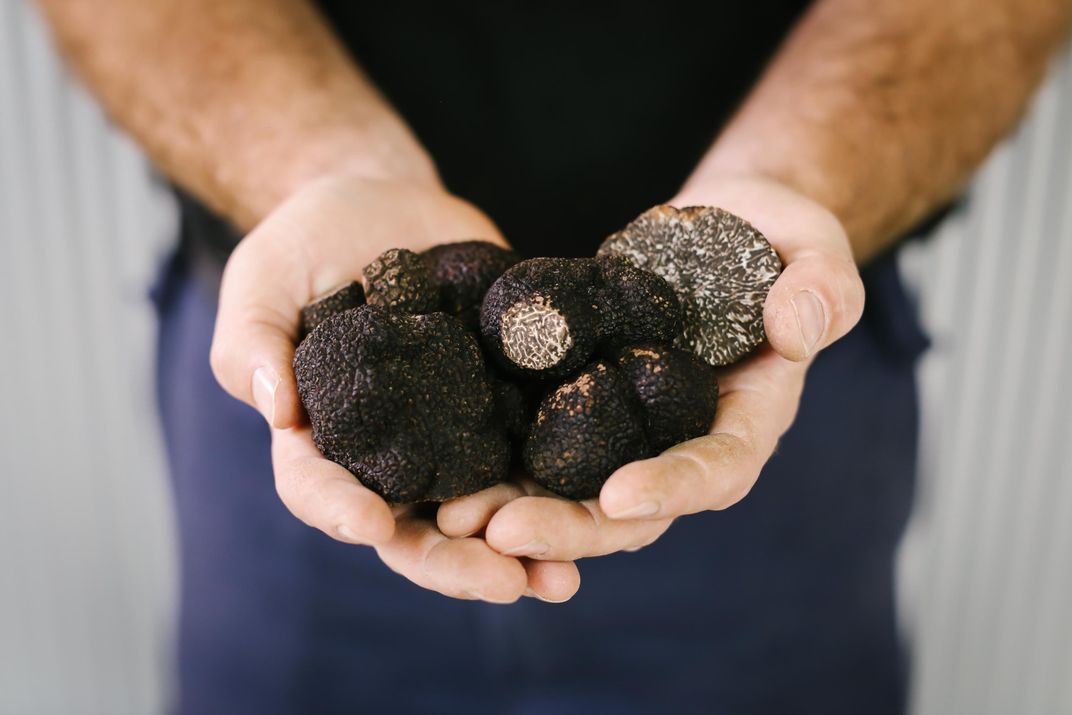These Adorable Rescue Dogs Lead Truffle Hunting Tours in Australia’s Majura Valley
An Australian farmer trains these abandoned canines to sleuth out a gourmet delicacy
Samson, a 10-year-old black Labrador retriever, buries his nose into a patch of softened earth shaded beneath a stand of oak trees. Using his keen sense of smell, he detects buried treasure: truffles.
As a reward for Samson’s find, Jayson Mesman, owner and farmer of The Truffle Farm, a farm he founded earlier this year in Canberra, Australia, plays a few rounds of fetch with a tennis ball, one of the dog’s favorite activities. But Samson’s life wasn’t always this ideal.
Before Mesman adopted him, Samson went from home to home, but always wound up being returned. Mesman, who had worked for several years training dogs for law enforcement, knew that Samson had a special gift. He took advantage of the dog’s sensitive nose, training him to ward off pests on his property. Samson’s sharp sense of smell was proven in 2007 when the duo visited The Truffle & Wine Co. in Western Australia, the largest producer of black truffles in the world.
“Within ten minutes he had found several kilos of truffles,” Mesman tells Smithsonian.com. “I immediately converted him from hunting pests to hunting truffles.”
Ever since, Samson has served as the 32-year-old farmer’s trusty sidekick in the hunt for Australian black truffles, a gourmet delicacy that has been known to fetch $1,200 for a one-pound specimen. Chefs from around the world clamor to get their hands on these “black diamonds,” shaving the umami-rich fungi onto steaks or infusing them into truffle oil. Although truffles can be found in places like France, Italy, Spain, and Oregon, Australia’s black truffles are some of the most covetable. Since the growing season is opposite that of the Northern Hemisphere, they’re available at off times of year—a treat for truffle lovers who want to get their fix year-round.
Along with Samson, Mesman has rescued five other dogs from the Australian Working Dog Rescue and other area shelters, naming them Simba, Nala, Willow, Bear and Max. Together he and his brood travel to area farms and assist farmers during the truffle harvest, which usually runs from June through September. In 2016, he purchased a farm three hours outside of Sydney and started one of his own. Its name is all too appropriate: The Truffle Farm.
“People often don’t believe that labs need rescuing, but there are about 390 in Australia each year that are available for adoption,” he says. “When [local shelters] found out what I was doing, they were excited to learn that I was giving these dogs a farm life.”
Ask any lab owner: Labradors need plenty of space to run around. These working dogs also have an incredibly keen sense of smell, according to the American Kennel Club. That sensitive schnoz means they’re sought out by hunters and law enforcement officers in addition to truffle hunters. But what are covetable characteristics to some are often what cause them to wind up in Australian shelters. Although they may appear cute and cuddly as puppies, Labradors can grow to be nearly 80 pounds in size once adults. According to Mesman, many Australians will adopt labs “when they’re small, like the ones you see in tissue commercials,” but soon realize they don’t have the space to house them.
“Two of mine were close to being put down,” he says. “I know that I could purchase one from a recognized breeder, but I realized it just adds to the problem. People thought that these dogs weren’t trainable, but I didn’t believe it. I took it as a challenge and wanted to prove them wrong. If you think about it, that’s what dogs do—it’s their primal instinct to sniff. So through positive reinforcement and rewards, I was able to train them to hunt truffles.”
To prove their capabilities, Mesman invites guests on truffle hunting tours with him and his dogs. On a typical day, his dogs can find anywhere between 20 and 50 kilos of truffles. An added bonus: Onsite chef Damian Brabender hosts breakfasts and wine lunches using found truffles on some tours.
“Although the dogs can work for extended periods, I try to make it a game for them,” Mesman says. “[Just like humans], once work no longer is fun, we no longer want to do it. So I don’t force them to do something when they’re not interested.” No wonder truffles are so rare—each represents the thrill of the hunt.
/https://tf-cmsv2-smithsonianmag-media.s3.amazonaws.com/filer/69/81/69818c82-d7e2-4234-9c77-09d0ea02c7a3/img_5323.jpg)

/https://tf-cmsv2-smithsonianmag-media.s3.amazonaws.com/filer/cd/f5/cdf57142-f6f4-4eed-b656-845c2259c985/img_5314.jpg)
/https://tf-cmsv2-smithsonianmag-media.s3.amazonaws.com/filer/36/f3/36f372e1-8311-4666-bacf-9dfdca4b674e/img_5321.jpg)
/https://tf-cmsv2-smithsonianmag-media.s3.amazonaws.com/filer/cc/b9/ccb9d3f8-6355-464d-89cd-9feb24b9659f/samson_and_a_french_oak.jpg)